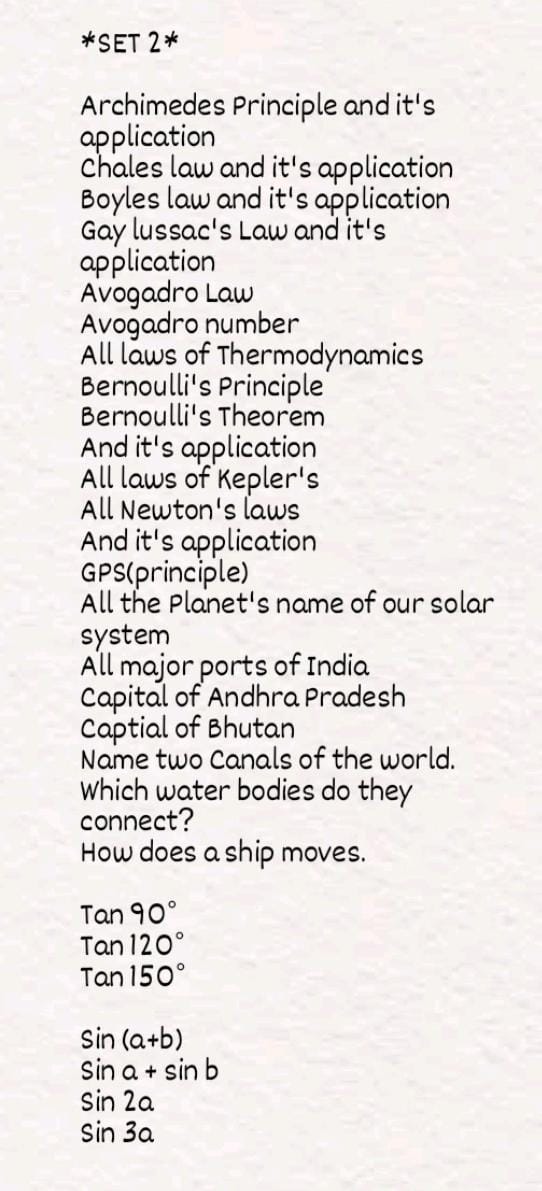Archimedes Principle and its application, Charles law and its application, Boyle's law and its application, Gay Lussac's Law and its application, Avogadro Law, Avogadro number, all... Archimedes Principle and its application, Charles law and its application, Boyle's law and its application, Gay Lussac's Law and its application, Avogadro Law, Avogadro number, all laws of Thermodynamics, Bernoulli's Principle, Bernoulli's Theorem and its application, all laws of Kepler's, all Newton's laws and its application, GPS principle, all the planets' names of our solar system, all major ports of India, capital of Andhra Pradesh, capital of Bhutan, name two canals of the world, which water bodies do they connect, how does a ship move, calculate Tan 90°, Tan 120°, Tan 150°, Sin(a+b), Sin a + Sin b, Sin 2a, Sin 3a.

Understand the Problem
The question lists a series of topics and questions covering various scientific principles, mathematical functions, and geographical information, asking for explanations, applications, and specific facts associated with those topics.
Answer
Archimedes: buoyancy; Newton: motion; GPS: satellites; Planets: Mercury to Neptune. Capitals: Amaravati (Andhra), Thimphu (Bhutan). Canals: Suez, Panama. Tan/Sin formulas for trigonometry.
Archimedes' Principle: Describes buoyancy. Charles' Law: Volume & temperature relationship in gases. Boyle's Law: Pressure & volume relationship in gases. Gay-Lussac's Law: Pressure & temperature relationship in gases. Avogadro's Law: Equal volumes of gases at the same temperature and pressure have equal numbers of molecules. Laws of Thermodynamics: Govern energy transformation. Bernoulli's Principle: Explains fluid behavior under varying flow conditions. Kepler's Laws: Describe planetary motion. Newton's Laws: Describe motion and gravity. GPS: Uses satellites for positioning. Planets: Mercury, Venus, Earth, Mars, Jupiter, Saturn, Uranus, Neptune. Major ports of India: Mumbai, Chennai, Kolkata. Capital of Andhra Pradesh: Amaravati. Capital of Bhutan: Thimphu. Suez Canal: Connects Mediterranean Sea and Red Sea. Panama Canal: Connects Atlantic Ocean and Pacific Ocean. A ship moves by propulsion (usually by engines or sails). Tan 90°: Undefined, Tan 120°: -√3, Tan 150°: -1/√3. Sin(a+b): sin a cos b + cos a sin b. Sin a + Sin b: 2 sin((a+b)/2) cos((a-b)/2). Sin 2a: 2 sin a cos a. Sin 3a: 3 sin a - 4 sin³ a.
Answer for screen readers
Archimedes' Principle: Describes buoyancy. Charles' Law: Volume & temperature relationship in gases. Boyle's Law: Pressure & volume relationship in gases. Gay-Lussac's Law: Pressure & temperature relationship in gases. Avogadro's Law: Equal volumes of gases at the same temperature and pressure have equal numbers of molecules. Laws of Thermodynamics: Govern energy transformation. Bernoulli's Principle: Explains fluid behavior under varying flow conditions. Kepler's Laws: Describe planetary motion. Newton's Laws: Describe motion and gravity. GPS: Uses satellites for positioning. Planets: Mercury, Venus, Earth, Mars, Jupiter, Saturn, Uranus, Neptune. Major ports of India: Mumbai, Chennai, Kolkata. Capital of Andhra Pradesh: Amaravati. Capital of Bhutan: Thimphu. Suez Canal: Connects Mediterranean Sea and Red Sea. Panama Canal: Connects Atlantic Ocean and Pacific Ocean. A ship moves by propulsion (usually by engines or sails). Tan 90°: Undefined, Tan 120°: -√3, Tan 150°: -1/√3. Sin(a+b): sin a cos b + cos a sin b. Sin a + Sin b: 2 sin((a+b)/2) cos((a-b)/2). Sin 2a: 2 sin a cos a. Sin 3a: 3 sin a - 4 sin³ a.
More Information
These principles and laws are foundational in physics and chemistry, explaining various natural phenomena and engineering applications. They play crucial roles in understanding the behavior of gases, movement, and the structure of the universe.
Tips
Common mistakes include confusing gas law relationships or misapplying trigonometric identities.
Sources
- The Simple Gas Laws- Boyle's Law, Charles's Law and Avogadro's - chem.libretexts.org
- 13.3 The Ideal Gas Law - College Physics 2e | OpenStax - openstax.org
AI-generated content may contain errors. Please verify critical information